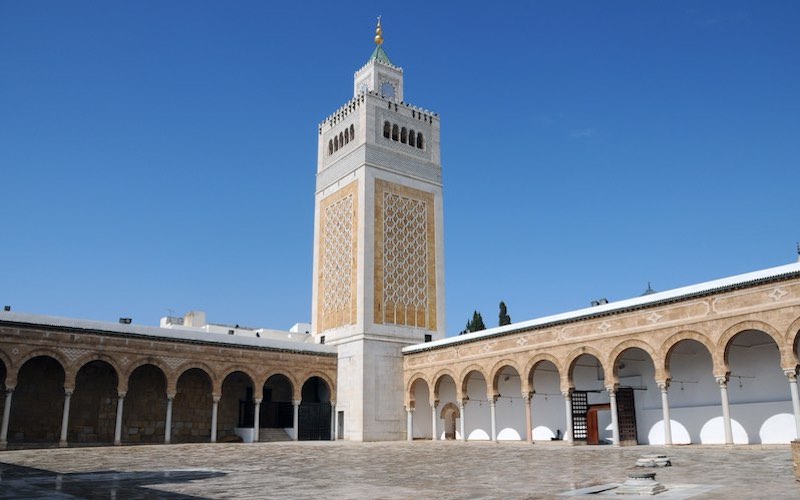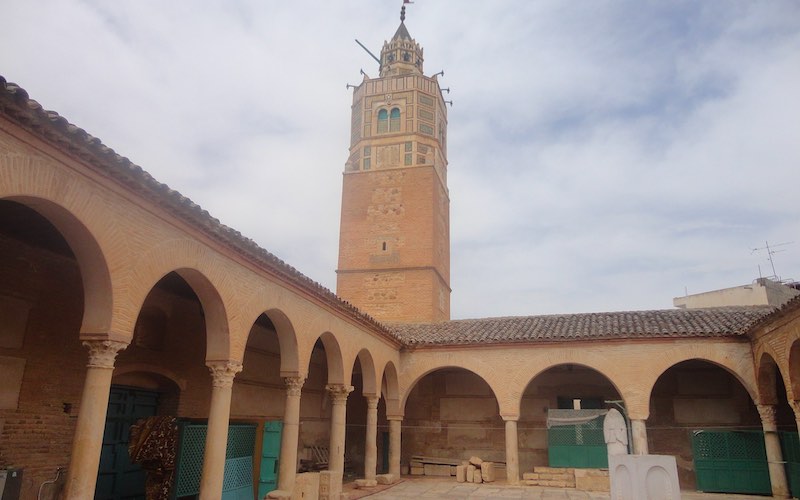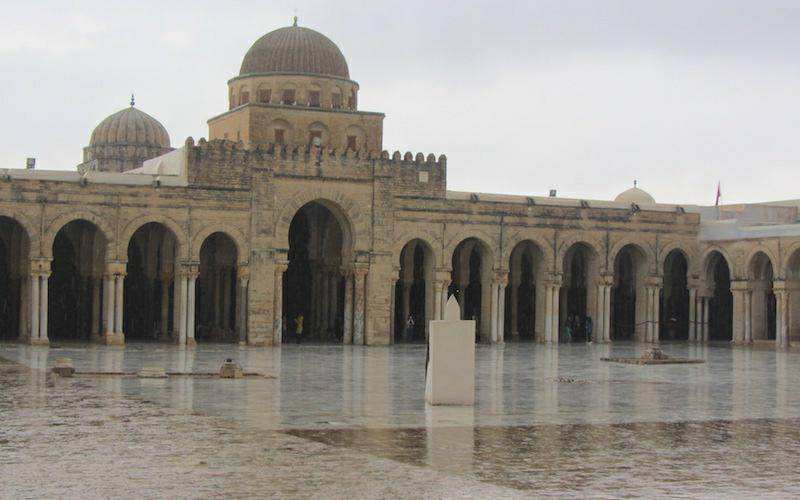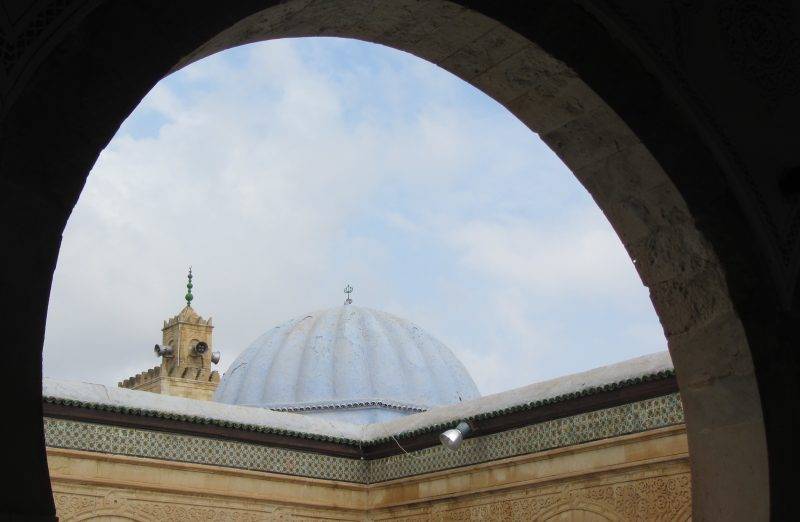Tunisia is home to many beautiful and historic mosques that are known for their architectural and cultural significance. There are so many amazing Mosques in Tunisia, so if you have an interest in Arabic architecture you won’t be disappointed. So, how many mosques are in Tunisia and can non-Muslim tourists visit then? What are the most famous Mosques in Tunisia?
How many Mosques are there in Tunisia?
It is estimated that there are over 5400 Mosques in Tunisia – it is almost impossible to count them all! If you enjoy visiting places of beautiful Islamic architecture, there Tunisia is for you!
Cam non-Muslims visit Mosques in Tunisia?
If you are visiting the famous Mosques in Tunisia as a non-Muslim tourist you may not be allowed inside some of the Mosques. However, often you will be able to view the courtyard from nearby rooftop cafes or enter the courtyard but not the actual mosque. Remember that you should be dressing modestly (women take a headscarf) and you should avoid drinking or smoking on the days that you are visiting the mosques. Remember also to consider and respect important Muslim festivals such as Eid.
What is interesting about the Mosques of Tunisia?
Tunisia has a long and rich history of Islamic architecture, with many beautiful mosques being built throughout the country over the centuries. The earliest mosques in Tunisia were built in the 7th and 8th centuries, during the Arab conquest of the region. These early mosques were often simple, functional structures, made of mud brick and clay, with little ornamentation.
As Islam spread throughout Tunisia, more and more mosques were built, each with its own unique architectural style.
But what I find most interesting is the creativity used in building these Mosques – many of the early mosques have utilised Roman columns in their construction – look carefully at the pillars supporting the courtyard arches. This is the case with the Great Mosque of Kairouan and the Great Mosque of Sousse.
Tips for Visiting the Mosques of Tunisia
There are a few things that you should bear in mind when visiting the famous Mosques of Tunisia:
- Dress conservatively and women should take a head scarf to wear.
- Accept that not all mosques in Tunisia are open to non-Muslim tourists.
- Remember that they are places of worship and you should remain quiet whilst inside Mosques and Mosque Courtyard. Shouting and swearing is not respectful.
- Avoid drinking alcohol or smoking on the days you are visiting the mosques.
- Take a water bottle with you as the weather in Tunisia can get very hot particularly in the summer months.
- If you go inside mosques it is always best to go in with a guided tour.
- Plan your visits around busy prayer times such as Friday Prayers.
- If you don’t speak Arabic, your French may help you as Tunisia is an ex French Colony.
The most Famous Mosques in Tunisia
Some of the most famous mosques in Tunisia include the Zitouna Mosque in Tunis, the Great Mosque of Sousse and the Great Mosque of Kairouan. Kairouan is actually home to three famous Mosques – the great Mosque of Kairouan, the Three Doors Mosque and the Mosque and Mausolean of Sidi Sahab. Kairouan is a very spiritual place for Muslims and. Kairouan is a holy city in Islam, ranking fourth in importance after Mecca, Medina and Jerusalem as a pilgrimage city. These mosques are known for their beautiful domes, minarets, and other decorative features, and are popular attractions in Tunisia.
Al-Zaytouna Mosque (or El-Zitouna Mosque)
This mosque, located in the centre of Tunis, is considered one of the most important and influential mosques in the country. It was founded in the 8th century and has undergone several renovations over the centuries. It is known for its grand size and beautiful architectural details, and is a popular tourist attraction.

Travel Tip: Non-Muslim tourists are not allowed inside the mosque or mosque courtyard, but it is possible to view the mosque courtyard from some of the cafe and shop rooftops nearby.
Hammouda Pacha Mosque
Hammouda Pacha Mosque is another mosque in the capital city of Tunis, and it is an official Tunisian historic monument. It was built in 1655 AD by Hammuda Pasha Bey (the second Bey of the Tunisian Muradid dynasty) in the Ottoman era. This is a Hanafi Mosque (the oldest of the four schools in Sunni Islam – one of the more liberal schools on Islamic law).
The Hammouda Pacha Mosque is within the Medina walls and was declared a UNESCO World Heritage Site in 1979 as part of Medina of Tunis. It is recognisable by its Octagonal minaret, green tiles roof and Turkish Architecture (see https://mosqpedia.org/en/mosque/951)
Great Mosque of Testour
The Great Mosque of Testour is a historic mosque located in the town of Testour, in the Béja Governorate of Tunisia. It was built in the 9th century, during the Aghlabid dynasty, and has undergone several renovations over the centuries. It is known for its beautiful architectural details, including intricate mosaics, marble columns, and carved stone. The most of Testour has Spanish influences with Andalusian style inscriptions and elements of Andalusian architecture.

The Great Mosque of Kairouan
Located in the city of Kairouan, this mosque is considered one of the most important and influential in the Islamic world. The Great Mosque of Kairouan is also known as the Mosque of Uqba. It was founded in the 7th century by the Arab general Uqba ibn Nafi and is the biggest Islamic monument in North Africa.
The Great Mosque of Kairouan is known for its grand size and beautiful architectural details, including intricate mosaics and marble columns. It is considered one of the oldest and most important mosques in the Islamic world. It is a large complex with a central courtyard, surrounded by arcades and covered by a series of domes. The mosque was built in a style influenced by Byzantine and Roman architecture, and features many intricate carvings and decorations.

Non-Muslim tourists are able to go in the Courtyard of the Mosque, where you will find a sundial and ancient irrigation system. Although non-Muslims are not allowed to go inside the Mosque itself, the large doors are partially open and give you a fantastic view of the inside. The main prayer hall is located on the southern side of the courtyard; and is accessed by 17 beautifully carved wooden doors.
Travel Tip: Spend a full day in Kairouan to visit the Great Mosque of Kairouan, the Three Doors Mosque, The Mosque and Tomb of Sidi Sahab and Kairouan Medina.
Three Doors Mosque (Kairouan)
Commissioned by Muhammad ibn Khairun in 866, the Three Doors Mosque (or Ibn Kayrun) is one of the oldest mosques in the world. You will find it tucked away down a side street inside the Medina. It’s small, but it’s age and well-preserved beauty are what makes it impressive.
In fact, the Three Doors Mosque has the oldest sculpted and decorated façade in Islamic art and includes the whole Kairouanese decorative repertoire of the Aghlabid period. The mosque is so-called because of its panel of three horseshoe shaped arches at the front of the Mosque which are again supported by columns sourced from antiquity.
Source: [https://islamicart.museumwnf.org/database_item.php?id=monument;isl;tn;mon01;26;en&cp]
The Mosque of Sidi Sahab
The Mausoleum and Mosque of Sidi Sahab is a historic religious complex located in the city of Kairouan, Tunisia. The complex consists of a mausoleum (tomb or burial place for an important person) a Mosque and a Madrasa (Qur’anic School). The buildings are dedicated to Sidi Sahab, who was a companion of the Prophet Mohammed (peace be upon him). Sidi Sahab died in 685 and a Madrasa added at a later date between 1629 and 1692.
It is informally known as ‘the Barber’s Mosque. This is because tradition says that Abou Djama el Balaoui (Sidi Sahab) always carried three hairs from the Prophet’s beard with him.

Tourists are allowed in the courtyards and also inside the Madrasa which is a stunningly beautiful example of Arabic art. This was one of the most beautiful things I saw in Tunisia and I highly recommend it.
Travel Tip: You will not be able to go inside the actually building containing the tomb itself, but when we were there there was a member of staff who would offer to go inside and take pictures for you (a small donation for the privilege is appreciated).
The Great Mosque of Sfax
Located in the city of Sfax, this mosque is known for its grand size and beautiful architectural details. It was built in the 9th century and has undergone several renovations over the centuries. One of the most distinctive features of the Great Mosque of Sfax is its three gates, which are decorated with intricate carvings and inscriptions. The mosque also has a number of minarets, which are tall, slender towers used for the call to prayer.
Travel Tip: The Great Mosque of Sfax is located in the heart of Sfax Medina and easily accessible by foot from anywhere in within the city walls.
The Great Mosque of Monastir
Located in the city of Monastir, this mosque is known for its grand size and beautiful architectural details. It was built in the 9th century and has undergone several renovations over the centuries. This Mosque has a prayer room and a minaret, but no internal courtyard. It is positioned in a beautiful setting, on the outskirts of the city overlooking the sea, near the Ribat of Monastir.
Travel Tip: The Mosque is walkable from the Ribat (fort) and although non-Muslims are not allowed to enter the prayer room, the doors are often left open so that you can look inside.
The Great Mosque of Sousse
Sousse is also home to several beautiful mosques, including the Great Mosque of Sousse, which was built in the 9th century ( 851 during the rule of Aghlabid Dynasty). It is known for its grand size and beautiful architectural details. It has a prayer hall, preceded by courtyard and several porticoes.
These are just a few examples of the many beautiful and historic mosques that can be found in Tunisia. No matter which one you choose to visit, you are sure to be struck by the beauty and significance of these important cultural and religious landmarks.
Further Reading on Tunisia
If you are visiting Tunisia, two other amazing historical sites that you should not miss are Carthage (the Roman Ruins in Tunis) and the Amphitheatre of El Jim (The Biggest Roman Ampitheatre outside of Rome). Here are some more of my Tunisia blogs that you might like to read:
- Mrs Holiday to Tunisia – The Good, the Bad and the Ugly!
- 10 Amazing things to do in Tunisia
- visiting the Amphitheatre of El Jim
- How to spend a weekend in Tunis
